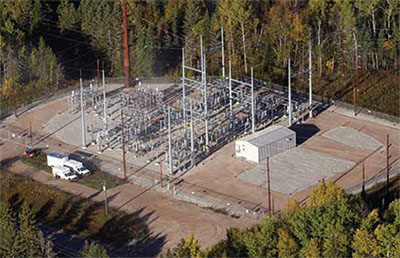Major projects update
DOE Smart Grid technology update
In 2010, ATC was awarded two Department of Energy matching grants to invest in Smart Grid data communication technologies. Those projects are substantially complete. An $11 million grant was used to install additional fiber optic cable and equipment to improve communication between substations and system operations centers. Through the use of overhead and underground fiber optic cable and back-up satellite technology, we have significantly reduced our dependence on leased communication services. This provides more secure and reliable operations and greatly enhances our ability to maintain operations in the event of a widespread telecommunications outage.
A $1 million grant to equip substations with a new technology to monitor the status of the grid has enhanced operators’ ability to analyze real-time events. Phasor measurement units provide a wider, more integrated and time-synchronized view of the transmission system. Thanks in large part to DOE funding, ATC now has more than 90 PMUs in service monitoring data on our entire 345-kV system. This data is being sent to MISO to augment regional operators’ visualization and analysis tools. ATC also has shared data to help interconnected customers analyze events on their systems including generator control issues and customer voltage events.
Pleasant Prairie-Zion Energy Center
Construction began earlier this year on a Multi-Value Project approved by regulators in Wisconsin and Illinois last year. The 5.3 mile, 345-kV line between substations in Pleasant Prairie, Wis., and Zion, Ill., will relieve congestion in the region and provide savings to electric utilities and their customers by enabling the most efficient generators to supply power to the energy market. It also will increase local and regional reliability by providing another high-voltage interconnection between the two states.
Straits HVDC Flow-Control Project
A new substation adjacent to the Straits Substation in St. Ignace, Mich., was placed in service earlier this year. The Mackinac Substation provides another measure of operating flexibility in the area, and is an integral part of a larger project to install a high-voltage, direct current flow‑control device to better manage power flows between Upper and Lower Michigan. The device will allow MISO to control power flow in and out of the Upper Peninsula, helping to accommodate the transmission of renewable wind energy being developed in the west. The flow control device is a less‑expensive and faster solution compared to a portfolio of transmission lines studied as alternatives.
Bay Lake
As currently proposed, Bay Lake is a package of proposals to address a delicate, shifting balance between generation, load and transmission in the northern portion of our service area. The project includes:
North Appleton-Morgan
- A 345-kV and 138-kV line from the North Appleton Substation in Outagamie County to the Morgan Substation in Oconto County, Wis.
- A large voltage-control device located near the Amberg Substation in Marinette County, Wis.
Holmes-Old Mead Road
- A single 138-kV line from the Holmes Substation in Menominee County to the Old Mead Road Substation in Escanaba, Mich.
MISO approved these projects in 2012. A regulatory application will be filed for the Michigan facilities in fall 2013, and for the Wisconsin facilities in the first quarter of 2014. In-service dates are anticipated to be late 2016 and mid-2017, respectively.
Badger Coulee
ATC and Xcel Energy plan to file a regulatory application with the Public Service Commission of Wisconsin this fall. Badger Coulee also is one of 17 MVPs approved by MISO in late 2011. The 160- to 180-mile, 345-kV line between La Crosse and Dane County areas will deliver reliability, economic and public policy benefits. The project will
- offset the need for about $160 million in lower‑voltage upgrades in western Wisconsin,
- provide increased access to the wholesale energy market and could provide up to $259 and $841 million in net economic benefits overthe life of the project and
- establish another pathway for renewable energy into Wisconsin with a connection to key load centers.
Cardinal Bluffs
Another MVP proposal between Madison, Wis., and Dubuque County, Iowa, is projected to provide benefits that exceed its cost. The 125-mile line would run from the Cardinal Substation to northern Dubuque County. The Cardinal Bluffs Project will improve local and regional reliability, deliver economic benefits by providing greater access to the wholesale market, and enable Iowa to bring more renewable generation to market. The project is a joint venture between ATC and ITC Midwest LLC.
Branch River
The unexpected closure of the Kewaunee Nuclear Station significantly affected our plans for a new 345-kV line in east central Wisconsin. The original Barnhart- Branch River project included two new substations and a 50-mile, 345-kV transmission line to address equipment modifications and an associated increase in generating capacity at the nearby Point Beach Nuclear Plant in Manitowoc County, Wis. Current plans call for building a new Branch River Substation in Manitowoc County and short segments of 345-kV line to tie into the existing network. Additional facilities will be installed at the Point Beach Substation.
